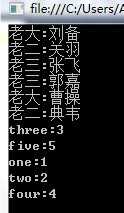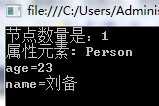http://blog.csdn.net/ligenyingsr/article/details/54095986
System.ConfigurationManager类用于对配置文件的读取。其具有的成员如下:
一、AppSettings
AppSetting是最简单的配置节,读写非常简单。
| 名称 | 说明 |
| AppSettings | 获取当前应用程序默认配置的 AppSettingsSection 数据 |
| ConnectionStrings | 获取当前应用程序默认配置的 ConnectionStringsSection 数据 |
<?xml version="1.0" encoding="utf-8" ?>
<configuration>
<appSettings>
<add key="DB" value="Access" />
</appSettings>
<connectionStrings>
<add name="connstr" connectionString="Provider=Microsoft.Jet.OLEDB.4.0;Data Source=F:\\C#Code\\DBOperation\\ykjj.mdb"/>
</connectionStrings>
</configuration>
示例:
class Program
{
static void Main(string[] args)
{
string strAppSettings = System.Configuration.ConfigurationManager.AppSettings["DB"]; //通过属性索引获取值
Console.WriteLine(strAppSettings);
string strConnection = System.Configuration.ConfigurationManager.ConnectionStrings["connstr"].ToString();
Console.WriteLine(strConnection);
Console.ReadKey();
}
}

对于以上这一个appSettings与connectionStrings都是由ConfigurationManager提供的两个属性来读取的。通常大多数的配置信息都可以放在appSettings里。但是如果你觉得不够用了,你还可以使用自定义配置信息。
二、自定义配置节
1、自带Handler
关于自定义配置节,Configuration提供了很多Handler类来供你选择使用。甚至如果你觉得不够,还可以自定义处理Handler。
先来学下使用怎么使用三个简单的Handler:
- System.Configuration.NameValueSectionHandler
- System.Configuration.DictionarySectionHandler
- System.Configuration.SingleTagSectionHandler
配置文件代码示例:
<?xml version="1.0" encoding="utf-8" ?>
<configuration>
<configSections>
<section name="Person" type="System.Configuration.NameValueSectionHandler"/> <!--以NameValue键值/对的形式返回配置节中的信息-->
<section name="Man" type="System.Configuration.DictionarySectionHandler"/> <!--以Dictionary字典键值对的形式返回配置节中的信息-->
<section name="Name" type="System.Configuration.SingleTagSectionHandler" /> <!--基础结构。处理 .config 文件中由单个 XML 标记所表示的各配置节。-->
</configSections>
<Person>
<add key="老大" value="刘备" />
<add key="老二" value="关羽" />
<add key="老三" value="张飞" />
</Person>
<Man>
<add key="老大" value="曹操" />
<add key="老二" value="典韦" />
<add key="老三" value="郭嘉" />
</Man>
<Name one="1" two="2" three="3" four="4" five="5" /> <!--注意是要单个节SingleTagSectionHandler才能处理,但是无论你索性有多少个也能处理-->
</configuration>
读取代码示例:
static void Main(string[] args)
{
//读取人名
NameValueCollection nvc = (NameValueCollection)ConfigurationManager.GetSection("Person");
foreach (string key in nvc.AllKeys)
{
Console.WriteLine(key + ":" + nvc[key]);
}
//读取男人
IDictionary dict = (IDictionary)ConfigurationManager.GetSection("Man");
foreach (string key in dict.Keys)
{
Console.WriteLine(key + ":" + dict[key]);
}
IDictionary dict1 = (IDictionary)ConfigurationManager.GetSection("Name");
foreach (string key in dict1.Keys)
{
Console.WriteLine(key + ":" + dict1[key]);
}
Console.ReadKey();
}
输出结果如下:

2、自定义Handler
自定义读取节点需要实现接口IConfigurationSectionHandler,并提供Create的具体实现。
Appconfig代码:
<?xml version="1.0" encoding="utf-8" ?>
<configuration>
<configSections> <!--后面的type是处理处理节点PersonHandler所在的位置第二个参数是程序集,你可以不要Version开始之后的-->
<section name="Person" type="ConsoleApplication1.PersonHandler,ConsoleApplication1,Version=1.0.0.0,Culture=neutral,PublicKeyToken=null" allowLocation="true" allowDefinition="Everywhere" />
</configSections>
<Person age="23" name="刘备" />
</configuration>
主程序代码:
class Program
{
static void Main(string[] args)
{
Hashtable config = ConfigurationManager.GetSection("Person") as Hashtable;
Console.WriteLine("节点数量是:" + config.Count);
//2重键值对的方式,其中deKey又可以再次转化为一个Hashtable
foreach (DictionaryEntry deKey in config)
{
Console.WriteLine("属性元素: " + deKey.Key.ToString());
Hashtable attribs = (Hashtable)deKey.Value;
foreach (DictionaryEntry deAttrib in attribs)
{
Console.WriteLine(deAttrib.Key.ToString() + "=" + deAttrib.Value.ToString());
}
}
Console.ReadKey();
}
}
//注意必须要实现IConfigurationSectionHandler接口
class PersonHandler : IConfigurationSectionHandler
{
public object Create(object parent, object configContext, System.Xml.XmlNode section)
{
Hashtable myConfig = new Hashtable();
// 本节元素,获取的任何属性。
Hashtable myAttribs = new Hashtable();
//遍历当前节点的属性
foreach (XmlAttribute attrib in section.Attributes)
{
//如果当前节点是属性节点,则添加进入myAttribs
if (XmlNodeType.Attribute == attrib.NodeType)
{
myAttribs.Add(attrib.Name, attrib.Value);
}
}
//把当前属性节点集合添加进myConfig
myConfig.Add(section.Name, myAttribs);
return myConfig;
}
}
输出结果如下:

这样的配置代码看起来还是有点吃力,毕竟Hashtable的层次有两层。
3、property属性的方式读取
- 使用这种方法,需要自定义一个类,并且要继承自ConfigurationSection基类。ConfigurationProperty的构造函数中传入的name字符串将会用于config文件中,表示各参数的属性名称。
- 属性的值的读写要调用this[]或base[],由基类去保存,请不要自行设计Field来保存。
- 为了能使用配置节点能被解析,需要在<configSections>中注册: <section name="Person" type="ConsoleApplication1.PersonSection,ConsoleApplication1,Version=1.0.0.0,Culture=neutral,PublicKeyToken=null" allowLocation="true" allowDefinition="Everywhere" /> ,且要注意name="Person"要与<Person ..... >是对应的。
先来看看配置文件的写法:
<?xml version="1.0" encoding="utf-8" ?>
<configuration>
<configSections> <!--后面的type是处理处理节点PersonSection所在的位置第二个参数是程序集,你可以不要Version开始之后的-->
<section name="Person" type="ConsoleApplication1.PersonSection,ConsoleApplication1,Version=1.0.0.0,Culture=neutral,PublicKeyToken=null" allowLocation="true" allowDefinition="Everywhere" />
</configSections>
<Person age="23" name="刘备" />
</configuration>
然后程序代码:
class Program
{
static void Main(string[] args)
{
PersonSection person = ConfigurationManager.GetSection("Person") as PersonSection;
Console.WriteLine("name={0},age={1}", person.Age, person.Name);
Console.ReadKey();
}
}
//注意 这里是继承自System.Configuration.ConfigurationSection了
class PersonSection : System.Configuration.ConfigurationSection
{
[ConfigurationProperty("age", IsRequired = false, DefaultValue = 0)]
public int Age
{
get { return (int)base["age"]; }
set { base["age"] = value; }
}
[ConfigurationProperty("name", IsRequired = false, DefaultValue = "")]
public string Name
{
get { return (string)base["name"]; }
set { base["name"] = value; }
}
}
输出结果如下:

4、配置子元素
对于稍微在复杂一点的结构,子元素的Model类要继承自ConfigurationElement。
config文件代码:
<?xml version="1.0" encoding="utf-8" ?>
<configuration>
<configSections>
<section name="complex" type="ConsoleApplication1.ComplexSection,ConsoleApplication1"/>
</configSections>
<complex height="182">
<child firstName="张" lastName="飞"/>
</complex>
</configuration>
主程序代码:
class Program
{
static void Main(string[] args)
{
ComplexSection sec = ConfigurationManager.GetSection("complex") as ComplexSection;
Console.WriteLine(sec.Height); //访问属性
Console.WriteLine(sec.Child.FirstName); //访问子节点属性
Console.WriteLine(sec.Child.LastName); //访问子节点属性
Console.ReadKey();
}
}
public class ComplexSection : ConfigurationSection
{
[ConfigurationProperty("height", IsRequired = true)]
public int Height
{
get { return (int)base["height"]; }
set { base["height"] = value; }
}
[ConfigurationProperty("child", IsDefaultCollection = false)]
public ChildSection Child
{
get { return (ChildSection)base["child"]; }
set { base["child"] = value; }
}
}
public class ChildSection : ConfigurationElement
{
[ConfigurationProperty("firstName", IsRequired = true, IsKey = true)]
public string FirstName
{
get { return (string)base["firstName"]; }
set { base["firstName"] = value; }
}
[ConfigurationProperty("lastName", IsRequired = true)]
public string LastName
{
get { return (string)base["lastName"]; }
set { base["lastName"] = value; }
}
}
输出结果如图所示:

5、配置文件中的CDATA
有时候,在配置文件里可能会包含一些比较复杂的代码段,这时候就要用到XML的CDATA了。
<?xml version="1.0" encoding="utf-8" ?>
<configuration>
<configSections>
<section name="MySection" type="ConsoleApplication1.MySection, ConsoleApplication1" />
</configSections>
<MySection>
<html>
<![CDATA[
<div style="# font-size:24px">加粗显示</div>
]]>
</HTML>
<SQL>
<![CDATA[
SELECT TOP 10 * FROM Person
]]>
</SQL>
</MySection>
</configuration>
主程序代码如下:
namespace ConsoleApplication1
{
class Program
{
static void Main(string[] args)
{
MySection section = ConfigurationManager.GetSection("MySection") as MySection;
Console.WriteLine("{0}{1}", section.HTML.CommandText, section.SQL.CommandText);
Console.ReadKey();
}
}
//注意 这里是继承自System.Configuration.ConfigurationSection了
class MySection : System.Configuration.ConfigurationSection
{
[ConfigurationProperty("HTML", IsRequired = false)]
public MyTextElement HTML
{
get { return (MyTextElement)base["HTML"]; }
set { base["HTML"] = value; }
}
[ConfigurationProperty("SQL", IsRequired = false)]
public MyTextElement SQL
{
get { return (MyTextElement)base["SQL"]; }
set { base["SQL"] = value; }
}
}
public class MyTextElement : ConfigurationElement
{
protected override void DeserializeElement(System.Xml.XmlReader reader, bool serializeCollectionKey)
{
CommandText = reader.ReadElementContentAs(typeof(string), null) as string;
}
protected override bool SerializeElement(System.Xml.XmlWriter writer, bool serializeCollectionKey)
{
if (writer != null)
{
writer.WriteCData(CommandText);
}
return true;
}
[ConfigurationProperty("data", IsRequired = false)]
public string CommandText
{
get { return this["data"].ToString(); }
set { this["data"] = value; }
}
}
}
输出如下:

6、配置元素Collection
类似下面的配置方式,在ASP.NET的HttpHandler, HttpModule中太常见了。
<?xml version="1.0" encoding="utf-8" ?>
<configuration>
<configSections>
<section name="MySection" type="ConsoleApplication1.MySection, ConsoleApplication1" />
</configSections>
<MySection>
<add key="a" value="刘备"></add>
<add key="b" value="关羽"></add>
<add key="c" value="张飞"></add>
</MySection>
</configuration>
实现代码如下:
class Program
{
static void Main(string[] args)
{
MySection section = ConfigurationManager.GetSection("MySection") as MySection;
foreach (MyKeyValueSetting add in section.KeyValues)
{
Console.WriteLine(add.Key + ":" + add.Value);
}
Console.ReadKey();
}
}
public class MySection : ConfigurationSection // 所有配置节点都要选择这个基类
{
private static readonly ConfigurationProperty s_property = new ConfigurationProperty(string.Empty, typeof(MyKeyValueCollection), null, ConfigurationPropertyOptions.IsDefaultCollection);
[ConfigurationProperty("", Options = ConfigurationPropertyOptions.IsDefaultCollection)]
public MyKeyValueCollection KeyValues
{
get
{
return (MyKeyValueCollection)base[s_property];
}
}
}
[ConfigurationCollection(typeof(MyKeyValueSetting))]
public class MyKeyValueCollection : ConfigurationElementCollection // 自定义一个集合
{
// 基本上,所有的方法都只要简单地调用基类的实现就可以了。
public MyKeyValueCollection() : base(StringComparer.OrdinalIgnoreCase) // 忽略大小写
{
}
// 其实关键就是这个索引器。但它也是调用基类的实现,只是做下类型转就行了。
new public MyKeyValueSetting this[string name]
{
get { return (MyKeyValueSetting)base.BaseGet(name); }
}
// 下面二个方法中抽象类中必须要实现的。
protected override ConfigurationElement CreateNewElement()
{
return new MyKeyValueSetting();
}
protected override object GetElementKey(ConfigurationElement element)
{
return ((MyKeyValueSetting)element).Key;
}
// 说明:如果不需要在代码中修改集合,可以不实现Add, Clear, Remove
public void Add(MyKeyValueSetting setting)
{
this.BaseAdd(setting);
}
public void Clear()
{
base.BaseClear();
}
public void Remove(string name)
{
base.BaseRemove(name);
}
}
public class MyKeyValueSetting : ConfigurationElement // 集合中的每个元素
{
[ConfigurationProperty("key", IsRequired = true